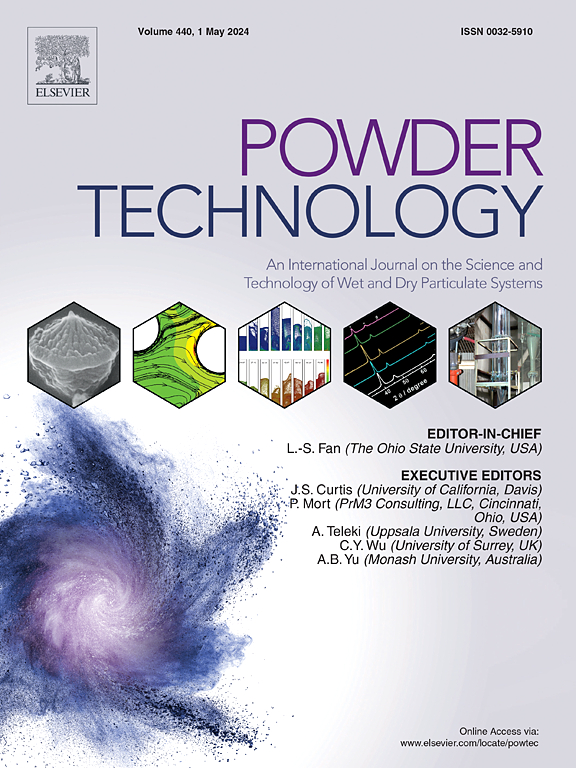Improving inhalation delivery of biologics with extra-large particles produced by spray freeze drying
IF 4.5
2区 工程技术
Q2 ENGINEERING, CHEMICAL
引用次数: 0
Abstract
Inhalation delivery of biologics as dry powders offers a promising alternative to liquid formulations, eliminating the need for cold storage. However, controlling particle properties for efficient lung delivery is challenging. While spray drying (SD) has been successfully used, it often requires excipients not approved for inhalation. In this study, spray freeze drying (SFD) was explored as an alternative technology. Human immunoglobulin G (hIgG) was used as a model molecule and dried in a mannitol-based formulation, approved for inhalation delivery. The effect of nozzle diameter (50–100 μm) and solids' concentration (5–10 %(w/w)) were investigated. Despite their large size (20–300 μm), SFD particles achieved fine particle doses over emitted doses (FPD/ED) up to 80 %, which was attributed to their low density (<0.52 g/cm3). The study highlights the SFD potential to enhance the aerodynamic performance of dry powder formulations for inhalation delivery, as demonstrated in comparative tests with SD.

改善喷雾冷冻干燥生产的超大颗粒生物制剂的吸入输送
吸入生物制剂作为干粉末提供了一个有前途的替代液体配方,消除了冷藏的需要。然而,控制颗粒的特性以实现有效的肺输送是具有挑战性的。虽然喷雾干燥(SD)已经成功使用,但它通常需要未经批准的吸入辅料。在这项研究中,喷雾冷冻干燥(SFD)作为一种替代技术进行了探索。人免疫球蛋白G (hIgG)被用作模型分子,并在甘露醇基础配方中干燥,批准吸入给药。考察了喷嘴直径(50 ~ 100 μm)和固体颗粒浓度(5 ~ 10% (w/w))的影响。尽管它们的尺寸很大(20-300 μm),但SFD颗粒的细颗粒剂量比辐射剂量(FPD/ED)高达80%,这归因于它们的低密度(0.52 g/cm3)。该研究强调了SFD在增强干粉吸入配方的空气动力学性能方面的潜力,与SD的对比试验证明了这一点。
本文章由计算机程序翻译,如有差异,请以英文原文为准。
求助全文
约1分钟内获得全文
求助全文
来源期刊

Powder Technology
工程技术-工程:化工
CiteScore
9.90
自引率
15.40%
发文量
1047
审稿时长
46 days
期刊介绍:
Powder Technology is an International Journal on the Science and Technology of Wet and Dry Particulate Systems. Powder Technology publishes papers on all aspects of the formation of particles and their characterisation and on the study of systems containing particulate solids. No limitation is imposed on the size of the particles, which may range from nanometre scale, as in pigments or aerosols, to that of mined or quarried materials. The following list of topics is not intended to be comprehensive, but rather to indicate typical subjects which fall within the scope of the journal's interests:
Formation and synthesis of particles by precipitation and other methods.
Modification of particles by agglomeration, coating, comminution and attrition.
Characterisation of the size, shape, surface area, pore structure and strength of particles and agglomerates (including the origins and effects of inter particle forces).
Packing, failure, flow and permeability of assemblies of particles.
Particle-particle interactions and suspension rheology.
Handling and processing operations such as slurry flow, fluidization, pneumatic conveying.
Interactions between particles and their environment, including delivery of particulate products to the body.
Applications of particle technology in production of pharmaceuticals, chemicals, foods, pigments, structural, and functional materials and in environmental and energy related matters.
For materials-oriented contributions we are looking for articles revealing the effect of particle/powder characteristics (size, morphology and composition, in that order) on material performance or functionality and, ideally, comparison to any industrial standard.
 求助内容:
求助内容: 应助结果提醒方式:
应助结果提醒方式:


